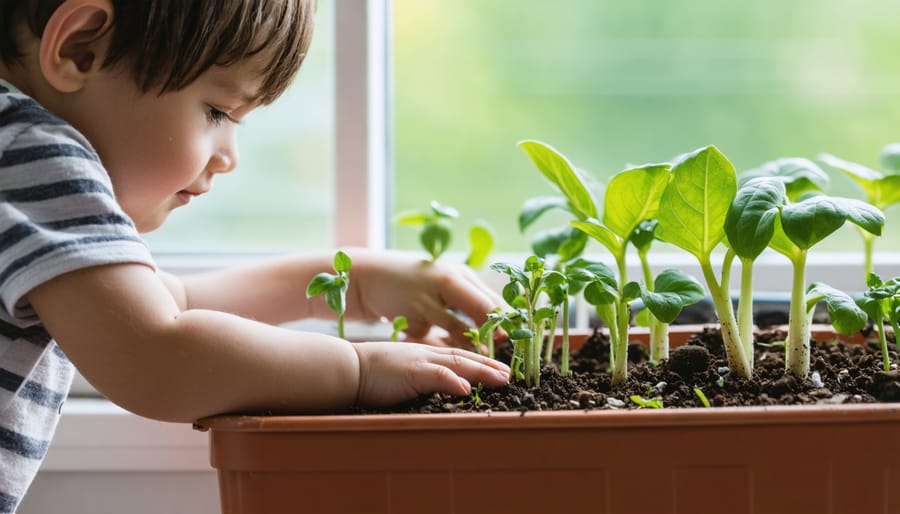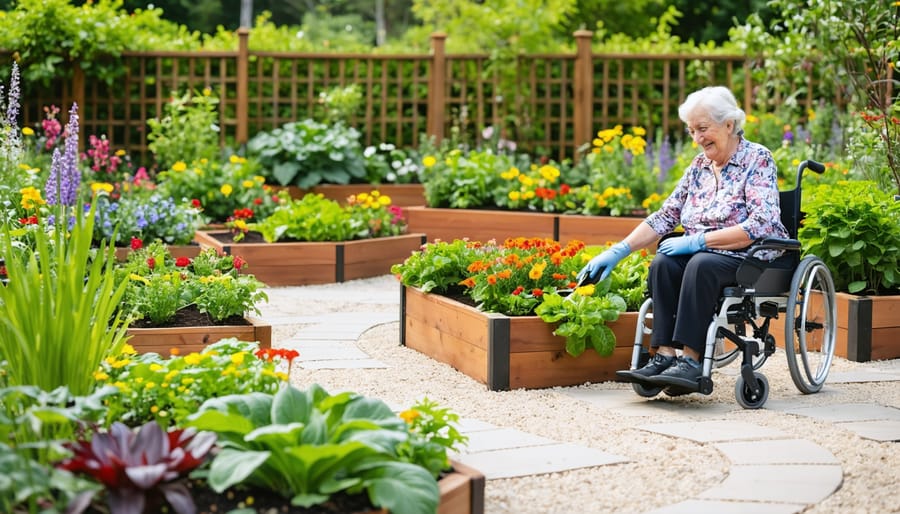Transform your garden into a senior-friendly oasis by raising beds to waist height, eliminating the need to bend or kneel while tending to plants. Install smooth, wide paths between garden areas using non-slip materials like textured concrete or compressed gravel, creating safe, wheelchair-accessible routes that prevent trips and falls. Replace heavy traditional tools with lightweight, ergonomic alternatives featuring extended handles and cushioned grips to reduce joint strain and maintain control while working.
Gardening doesn’t require sacrificing your favorite hobby as you age – it simply means adapting your space and methods for comfort and safety. Strategic placement of benches throughout the garden provides essential rest spots, while vertical growing systems bring plants to eye level, making maintenance effortless. Installing automated watering systems eliminates the need to carry heavy watering cans, while choosing perennial plants over annuals reduces yearly replanting efforts.
These thoughtful modifications preserve the joy of gardening while protecting your body, ensuring you can continue nurturing your green space for years to come.
Ergonomic Tools That Save Your Back and Joints
Long-Handled Tools for Less Bending
Long-handled tools are a game-changer for senior gardeners, making it possible to tend to your beloved garden without excessive bending or strain. Look for tools with handles that extend 2-3 feet or longer, which allow you to work from a comfortable standing position. Essential additions to your toolkit should include a long-handled trowel for planting, an extended cultivator for loosening soil, and an ergonomic rake with an adjustable handle.
Many modern garden tools now come with telescoping handles that can be adjusted to your preferred length. These are particularly useful when working with raised beds or ground-level plantings. Consider investing in tools with D-shaped handles at the end, which provide better grip and control while reducing wrist strain.
For pruning and trimming, long-handled loppers and pruning poles are invaluable. They let you reach high branches and maintain shrubs without using a ladder. Look for lightweight materials like aluminum or carbon fiber, which provide strength without adding unnecessary weight. Some tools even feature rotating handles that move with your natural motion, further reducing strain on your joints and muscles.
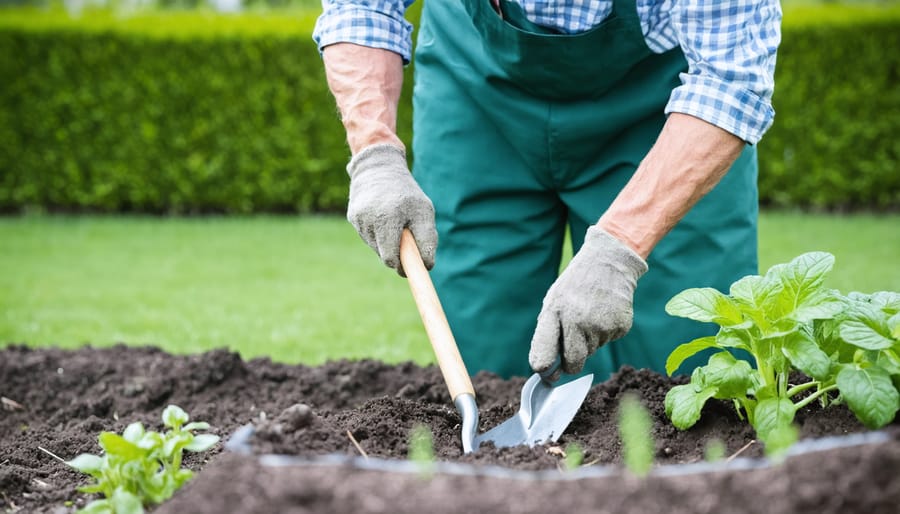
Lightweight and Easy-Grip Options
When strength isn’t what it used to be, the right tools can make all the difference in your garden. Tools designed for arthritis and limited mobility feature ergonomic handles with soft, cushioned grips that reduce strain on joints and muscles. Look for tools with extended handles to minimize bending, and opt for those made from lightweight materials like aluminum or carbon fiber instead of traditional steel.
Many modern garden tools now come with pistol-grip handles that keep your wrist in a natural position, preventing unnecessary twisting. Foam-padded handles provide excellent grip even when wet, while tools with bright-colored handles are easier to spot if dropped among plants.
Consider investing in spring-action pruners that do most of the work for you, and telescoping tools that adjust to your preferred length. Hand trowels and forks with wrist supports help distribute pressure more evenly across your hand, making digging and planting less strenuous. Remember, lighter tools might need replacing more often, but they’re worth it for the comfort they provide while gardening.
Smart Garden Design for Easier Maintenance
Raised Beds and Container Gardens
Raised beds and container gardens are game-changers for gardening with limited mobility. These elevated growing spaces bring plants closer to you, eliminating the need to bend down or kneel on the ground. By positioning your garden at waist height, you can tend to your plants while standing or sitting comfortably in a chair.
Consider starting with containers on sturdy tables or investing in purpose-built raised beds that stand about 30-36 inches tall. Look for beds with a width of no more than 4 feet, ensuring you can easily reach the center from either side. Many companies now offer modular raised bed kits that are simple to assemble and can be customized to your space and needs.
Container gardening offers incredible flexibility – you can grow everything from herbs to tomatoes in pots placed at comfortable heights. Choose lightweight containers with wheels for easy repositioning, and remember to incorporate proper drainage holes. For raised beds, include a sitting ledge around the perimeter for rest breaks during longer gardening sessions.
Fill your elevated gardens with high-quality potting mix blended with compost for optimal growing conditions. Consider installing a simple irrigation system with a timer to reduce the physical demands of watering. This setup not only makes gardening more accessible but also creates an organized and attractive growing space that’s a joy to tend.
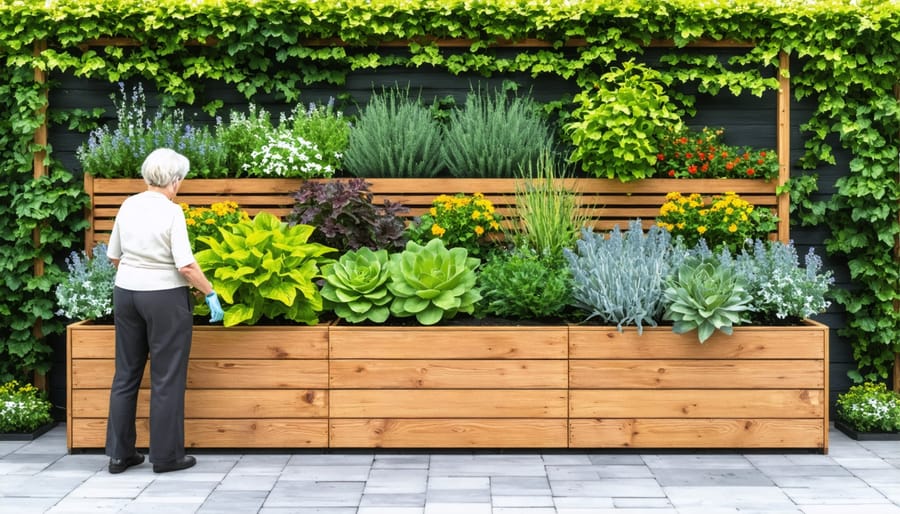
Vertical Gardening Solutions
Vertical gardening is a game-changer for elderly gardeners, allowing them to continue their beloved hobby without the strain of constant bending and stretching. By utilizing wall space and vertical structures, you can create an accessible garden that’s both beautiful and easy to maintain.
Start by installing sturdy trellises or wall-mounted planters at comfortable reaching height. These can be placed along fences, walls, or even on the side of a shed. Consider using lightweight fabric pocket planters or modular systems that can be adjusted to your preferred height.
For climbing plants, install guide wires or mesh panels that allow vines to grow upward naturally. Plants like cherry tomatoes, pole beans, and climbing peas are perfect for vertical gardens and can be easily harvested while standing. Trailing flowers like nasturtiums and morning glories add beautiful cascading color at eye level.
Don’t forget about hanging baskets with adjustable pulley systems, which can be lowered for watering and maintenance, then raised back up for display. Place these at strategic points around your garden space, ensuring they’re within comfortable reach when lowered.
For added convenience, incorporate an automatic watering system with drip lines or soaker hoses. This reduces the need to carry heavy watering cans and ensures your vertical garden stays consistently hydrated. Remember to position plants that need frequent attention at the most accessible heights, keeping lower-maintenance plants higher up.
Low-Maintenance Planting Strategies
Easy-Care Plants for Senior Gardens
When it comes to low-maintenance gardening, choosing the right plants can make all the difference. Succulents and cacti are excellent choices as they require minimal watering and thrive with little attention. Herbs like rosemary, thyme, and sage are not only drought-resistant but also provide fresh flavors for cooking.
Perennial flowers such as black-eyed susans, coneflowers, and daylilies come back year after year with little fuss. These hardy plants are known for their resilience and long blooming periods. Lavender is another fantastic option, offering beautiful blooms and a delightful fragrance while being notably drought-tolerant.
For ground cover, consider creeping thyme or sedum, which spread naturally and help suppress weeds. Native plants are particularly well-suited for easy-care gardens as they’re already adapted to your local climate and soil conditions.
If you enjoy growing vegetables, bush beans, cherry tomatoes, and leafy greens like Swiss chard are relatively easy to maintain and provide bountiful harvests. Container-friendly varieties are especially convenient as they can be placed at comfortable heights.
Remember to group plants with similar water needs together to simplify maintenance, and consider installing a simple drip irrigation system to make watering effortless.
Time-Saving Watering Systems
Installing an automated watering system can significantly reduce the physical demands of garden maintenance. Drip irrigation systems are perfect for elderly gardeners, delivering water directly to plant roots while eliminating the need to carry heavy watering cans or manage unwieldy hoses. These systems can be set up with timers, ensuring plants receive consistent water even when you’re unable to tend to the garden.
For container gardens, self-watering planters are an excellent investment. These clever containers feature a water reservoir at the bottom that keeps soil consistently moist through capillary action, reducing watering frequency to once every week or two. Similarly, soaker hoses laid throughout garden beds provide efficient, hands-free watering with minimal setup.
Consider installing a rain barrel near your garden to collect rainwater, and connect it to your irrigation system. Position it slightly elevated to use gravity for water flow, making it easier to fill watering cans when needed. For potted plants, water-retaining crystals mixed into the soil can help maintain moisture levels longer, reducing watering frequency.
Smart irrigation controllers can further simplify watering by automatically adjusting schedules based on weather conditions, ensuring your garden stays healthy with minimal intervention on your part.
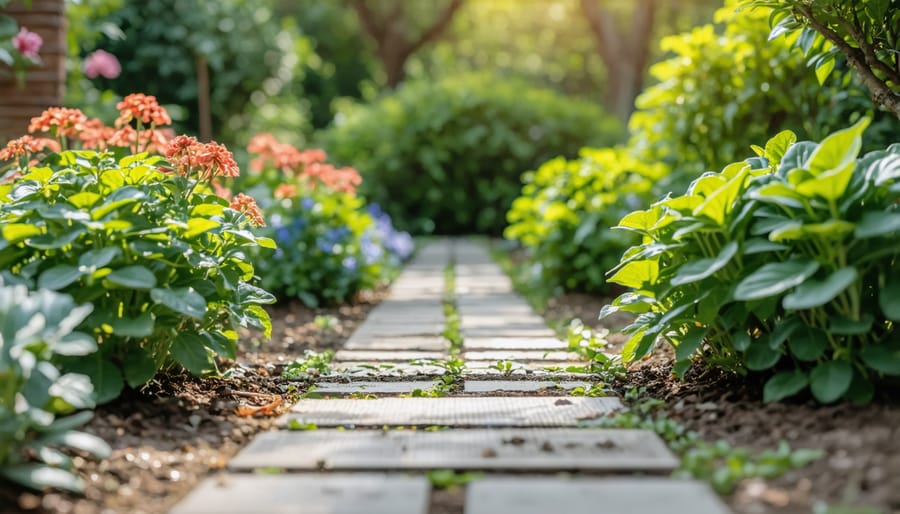
Safety First: Preventing Garden Accidents
Safety should always be your top priority when enjoying your garden. Protecting your body while gardening starts with simple precautions that can prevent accidents and injuries.
First, wear appropriate footwear with non-slip soles and good ankle support. Garden paths can become slippery, especially after watering or rain, so proper shoes are essential. Consider adding handrails along garden paths and steps for extra stability when moving around your garden.
Always keep your cell phone within reach while gardening. In case of emergency, you’ll want to be able to call for help quickly. It’s also wise to garden during cooler hours and take regular breaks to prevent overexertion and dehydration. Keep a water bottle nearby and rest in a shaded area when needed.
Be mindful of trip hazards like tools, hoses, or uneven surfaces. Store tools properly after use and ensure garden hoses are coiled neatly. Installing motion-sensor lights can help you see clearly if you’re gardening during early morning or evening hours.
Remember to pace yourself and listen to your body. If something feels too strenuous, there’s usually an easier way to accomplish the task. Consider gardening with a friend or family member – it’s not only safer but more enjoyable to share your garden time with others.
Gardening is a lifelong joy that doesn’t have to diminish with age. By implementing the strategies we’ve discussed, you can continue nurturing your garden while protecting your health and energy. Remember to start small, take regular breaks, and listen to your body. Consider joining a local gardening club for seniors to share tips and experiences with fellow enthusiasts. Don’t hesitate to ask family members or neighbors for help with more demanding tasks – gardening can be a wonderful way to strengthen community bonds. With the right tools, smart planning, and a positive attitude, you can keep your green thumb active for years to come. After all, gardens, like their caretakers, only grow more beautiful and wise with time. Keep growing, keep learning, and most importantly, keep enjoying the therapeutic benefits of tending to your garden paradise.


